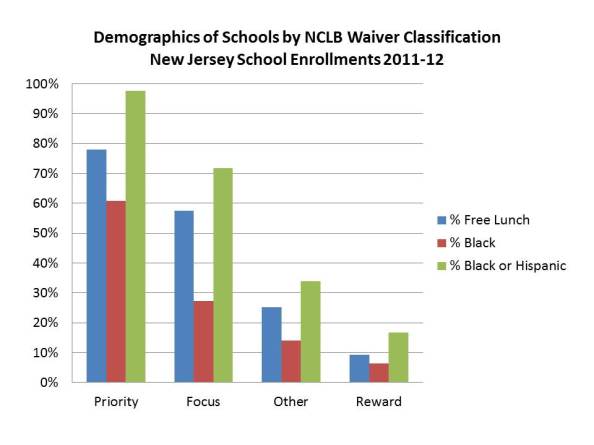Following the State of the Schools Address last week by Ed Commish Chris Cerf, another of Jeb Bush's Chiefs of Change, Bruce Baker took time to elegantly eviscerate the State's misleading and disingenuous analysis, particularly in relation to low-scoring, high-poverty schools (priority schools). Below is a small clip from Baker's takedown, which describes the connections among race, class, and test performance, which the Cerf plan for corporate charter school privatization ignores. Do read the entire post, for it is relevant to every state where public education is being displaced by corporate-run schools funded with public dollars.
. . . .Most notable, as I show below, priority schools have about 80% of children qualified for free lunch and reward schools less than 10%! Yet as the NJDOE slide above shows, at the high end these school districts spend slightly under 30% more than state average. Notably, this shoddy comparison does not compare these districts to others in their own labor market.
Indeed, New Jersey more than other states has put some money into these districts. See “Is school funding fair?” But, let’s be clear, these margins of funding difference, while helpful, hardly make these districts – given their needs – flush with excess resources!
In fact, the strongest empirical research on this topic suggests that it would take an additional 100% or so per pupil funding for a district that is 100% low income versus a district that is 0% low income. Here, we are looking at nearly that extreme of low income differential, and not nearly that extreme of funding support! So while these districts are better off than similar districts in other states, implying that they’ve got more than enough to close achievement gaps is a huge stretch.
But do those demographic differences matter?
This figure shows just how much the demographic differences represented above matter with respect to student achievement, and specifically how much school demography continues to dictate the performance classification of schools under the NJDOE waiver plan.
As I pointed out on a recent post, NJDOE has basically flagged schools in low income neighborhoods for experimentation and substantial disruption (closure, etc.) with an option to override any/all local input.
Notably, this pattern is likely better than it would otherwise be because of New Jersey’s past efforts to target additional resources to high need settings, including pre-kindergarten programs, smaller class sizes and more competitive teacher salaries than might otherwise exist in these settings.


No comments:
Post a Comment